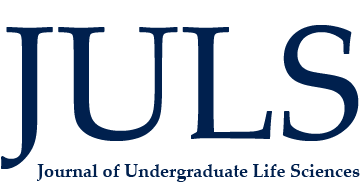Primary Research Manuscript Guidelines
In a primary research article, authors should present original research addressing an interesting and novel question in an area of the life sciences. If multiple authors are involved, the submitter(s) must obtain permission from co-authors and supervisors prior to submission.
The total length of the article should not exceed 4000 words in the main text, which does not include the title page, abstract, methods section, figure legends, or reference list (including in-text citations). The total number of display items (Figures and Tables) must not exceed ten (10); this excludes supplementary figures and tables. These limits may be adjusted depending on the paper submitted and at the discretion of the Editors.
Submissions should be formatted according to the following sections:
Title page
This section should contain a title of no more than 10-12 words that captures the conceptual significance for a broad audience. Titles should avoid the use of jargon, non-standard abbreviations, and punctuation. This section should also contain full names (including the initials of middle names) and affiliations of all authors, with the corresponding author’s email address. Please indicate authors with equal contributions. Please also include 3-5 keywords associated with your paper.
Abstract
Provide a brief abstract of no more than 250 words. Abstracts must be structured, including sections for background/introduction, methods, results, and conclusions. Abstracts should succinctly and clearly introduce the topic of the paper, summarize the main findings, and highlight the significance of the conclusions. Do not include references and avoid non-standard abbreviations in the abstract.
Introduction
Present relevant and appropriate background information required to set the results into proper context. The specific goals of the project should also be given, along with the rationale for the experiments. This section should not contain subheadings.
Methods
Provide details regarding experimental procedures, materials and equipment. To ensure a comprehensive description of the methods, this section does not count towards the word limit for the article length. The methods should be divided into sections, including reagents, animal models, and statistical analysis. Provide all names for the equipment and reagent suppliers (including catalogue numbers). Experimental organisms should be denoted with Latin taxonomic identifiers. More detailed reporting of protocols or reagents can be provided in supplementary text or tables.
Appropriate ethics regulations and committee approval should be declared. Experiments on live vertebrates or higher invertebrates must be performed in accordance with institutional and national guidelines. For studies involving humans, the sex and gender (or both) must be reported for subjects. We also require age and the developmental stage of subjects; if there are technical reasons why this data cannot be reported, a statement must be provided to disclose this.
Results
Present the data obtained form the research with appropriate statistical analysis. This section should be broken up by subheadings to organize the findings presented.
Discussion
Address the implications that the results present. Describe the relevance of the data with respect to the current understanding of the problems being studied in the field. This section may contain subheadings to highlight important areas that are expanded on in the text.
Acknowledgements
Mention contributions from non-authors and funding sources who supported the research presented.
Competing Interests
Identify potential influences that readers may consider when reviewing the presented research. Authors without financial or competing interests should explicitly include the statement “No competing interests declared”.
Data Availability
Publicly available datasets supporting your work should be included in this section. Please include the repository name, identifier, and hyperlink to the dataset.
References
References cited in text, tables, and figure legends should be included in a single reference list in this section. The JULS encourages citation of primary literature over review articles. There is no limit on the number of references. Cite all references in Nature style; JULS strongly recommends the use of integrated citation managers for preparation.
Figure Legends
Legends should be included in a separate document. The first sentence of each legend should be bolded and it should summarize the figure. Panels should be labelled with uppercase letters, with each panel described in the legend. Define abbreviations not included in the main text.
Supplementary Information
There is no maximum for supplementary information pages that are provided alongside submission. Please submit supplementary data as a single Microsoft Word or PDF file. Large tables may be submitted as Microsoft Excel files. Supplementary data is subject to the same peer review guidelines and criteria as main figure data.


